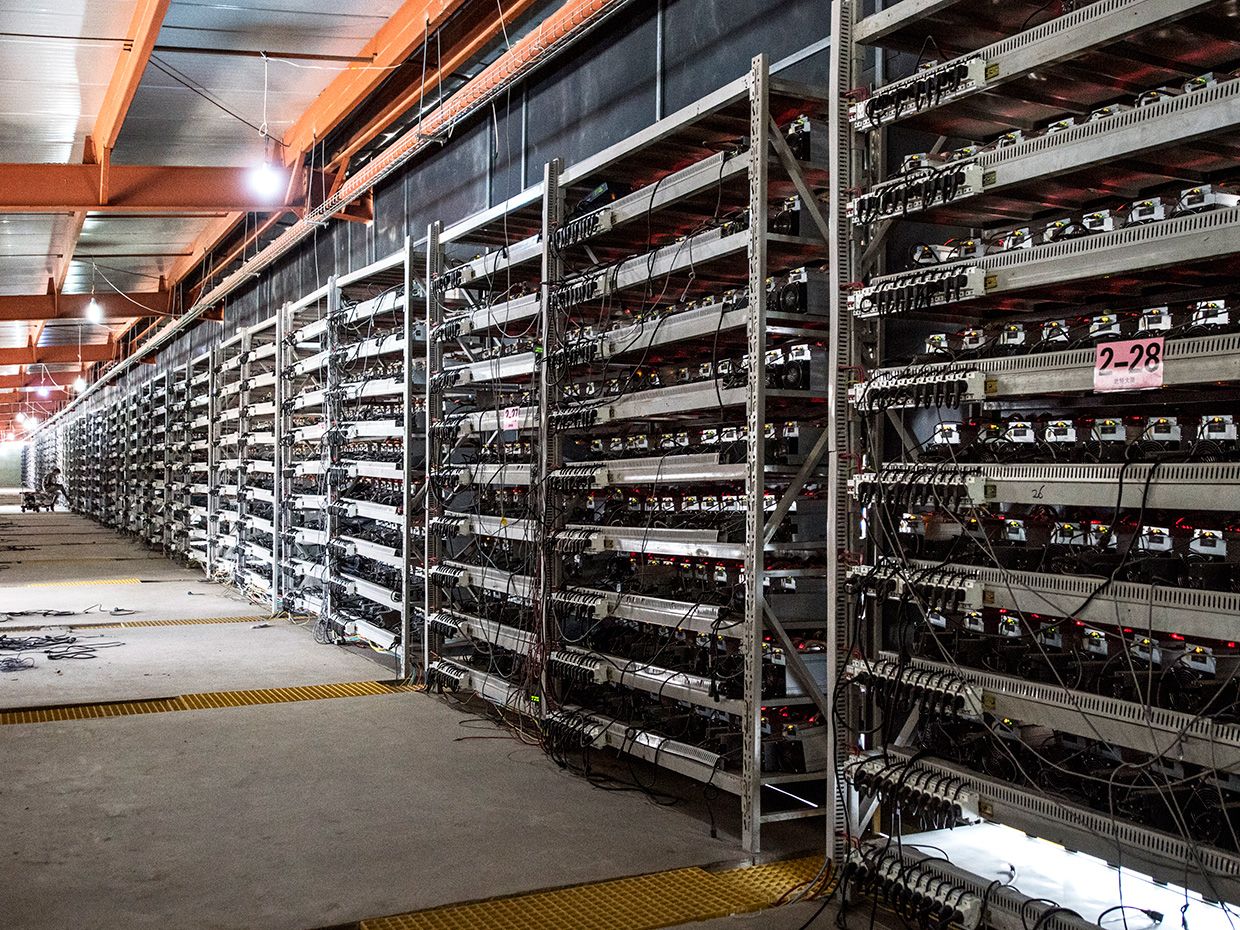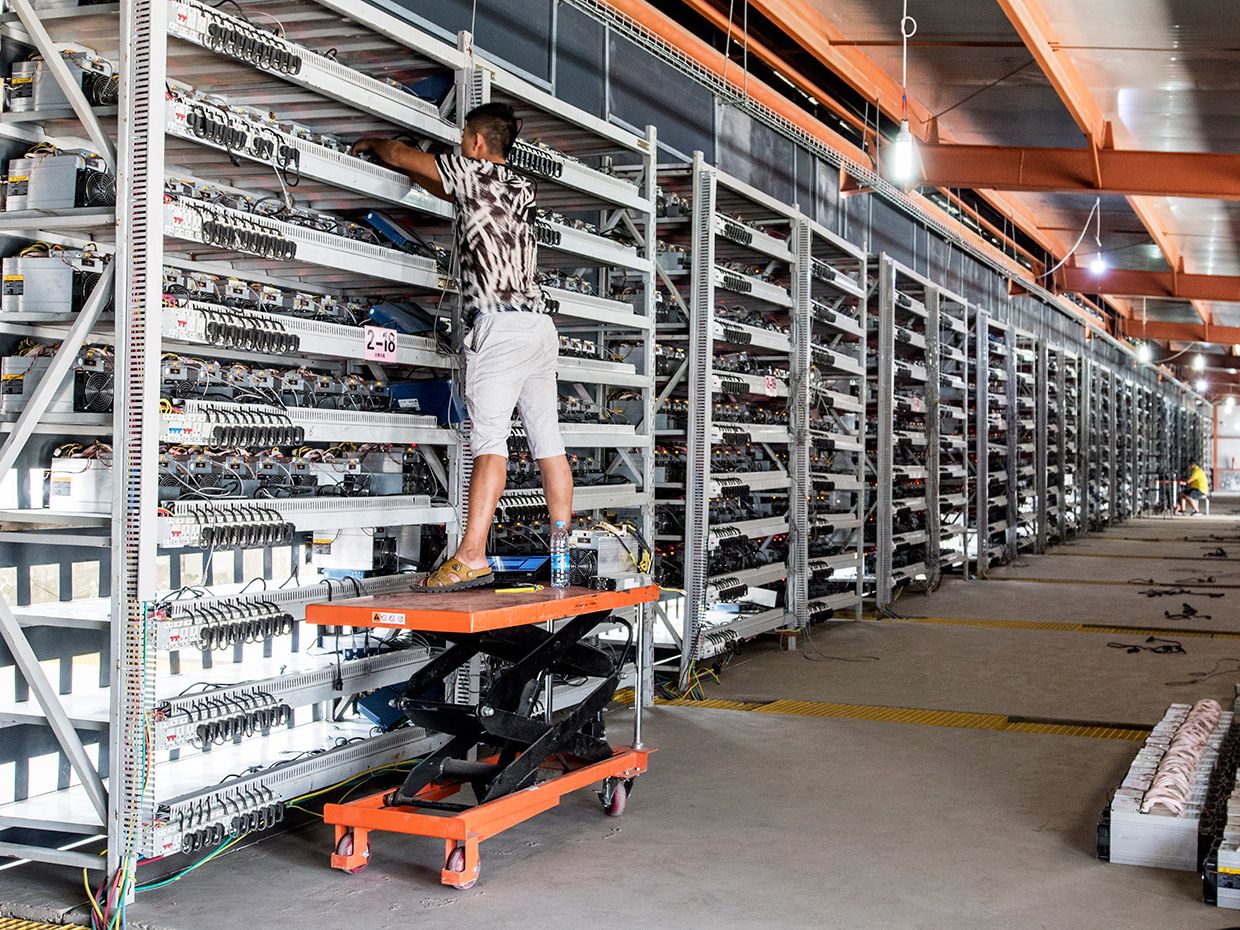The heart of Bitcoin is now in Inner Mongolia, where dirty coal fuels sophisticated semiconductor engineering

Inner Mongolia, 8 a.m.: A measurable fraction of all the computing power on the Bitcoin network is on these shelves.
It’s only 8 in the morning when I arrive at my destination in the Ordos prefecture of Inner Mongolia, but already the air is heavy and oppressively hot. My host drives me through a gate, past a sleepy-looking security guard, and into an industrial yard that extends into the dry, barren countryside about as far as I can see.
In front of me are nine warehouses with bright blue roofs, each emblazoned with the logo for Bitmain, a Chinese firm headquartered in Beijing that is arguably the most important company in the Bitcoin industry. Bitmain sells Bitcoin mining rigs—the specialized computers that keep the cryptocurrency running and that produce, or “mine,” new bitcoins for their owners. It also uses its own rigs to stock facilities that it owns or co-owns and operates. Bitmain owns about 20 percent of this one.
Jihan Wu, the CEO of Bitmain, claims that 70 percent of the Bitcoin mining rigs in operation today were made by his company. And, according to a study conducted last winter by the University of Cambridge, in England, it’s likely that most of those machines are plugged into an outlet somewhere in China.
Bitmain acquired this mining facility in Inner Mongolia a couple years ago and has turned it into one of the most powerful money factories on the Bitcoin network. It quite literally metabolizes electricity into money. By my own calculations, the hardware on the grounds—some 21,000 computers—accounted for about 4 percent of all the computing power in the Bitcoin network when I visited.
Like 10-ton paperweights, these machines bear down on the globally distributed ledger of transactions that is Bitcoin, keeping its pages from ever turning backward. Here is where the supply of existing bitcoins is secured. And here is where the banquet of new bitcoins is served.

Speedy Installation: The faster the machines are
plugged in, the sooner they can begin gulping down electricity and
turning it into money. Racks of bitcoin mining rigs run the length of
seven warehouses at Bitmain’s Ordos facility, which is in a constant
state of upgrade.
The process of mining bitcoins works like a lottery. Bitcoin miners are competing to produce hashes—alphanumeric strings of a fixed length that are calculated from data of an arbitrary length. They’re producing the hashes from a combination of three pieces of data: new blocks of Bitcoin transactions; the last block on the blockchain; and a random number. These are collectively referred to as the “block header” for the current block. Each time miners perform the hash function on the block header with a new random number, they get a new result. To win the lottery, a miner must find a hash that begins with a certain number of zeroes. Just how many zeroes are required is a shifting parameter determined by how much computing power is attached to the Bitcoin network. Every two weeks, on average, the mining software automatically readjusts the number of leading zeros needed—the difficulty level—by looking at how fast new blocks of Bitcoin transactions were added. The algorithm is aiming for a latency of 10 minutes between blocks. When miners boost the computing power on the network, they temporarily increase the rate of block creation. The network senses the change and then ratchets up the difficulty level. When a miner’s computer finds a winning hash, it broadcasts the block header to its next peers in the Bitcoin network, which check it and then propagate it further.
Then two things happen. New transactions are added to the Bitcoin blockchain ledger, and the winning miner is rewarded with newly minted bitcoins. The miner also collects small fees that users voluntarily tack onto their transactions as a way of pushing them to the head of the line. It’s ultimately an exchange of electricity for coins, mediated by a whole lot of computing power. The probability of an individual miner winning the lottery depends entirely on the speed at which that miner can generate new hashes relative to the speed of all other miners combined. In this way, the lottery is more like a raffle, where the more tickets you buy in comparison to everyone else makes it more likely that your name will be pulled out of the hat.
These dynamics have resulted in a race among miners to amass the fastest, most energy-efficient chips. And the demand for faster equipment has spawned a new industry devoted entirely to the computational needs of Bitcoin miners. Until late 2013, generic graphics cards and field-programmable gate arrays (FPGAs) were powerful enough to put you in the race. But that same year companies began to sell computer chips, called application-specific integrated circuits (ASICs), which are specifically designed for the task of computing the Bitcoin hashing algorithm. Today, ASICs are the standard technology found in every large-scale facility, including the mining farm in Ordos. When Bitmain first started making ASICs in 2013, the field was thick with competitors—BitFury, a multinational ASIC maker; KnCMiner in Stockholm; Butterfly Labs in the United States; Canaan Creative in Beijing; and about 20 other companies spread around China....MUCH MORE